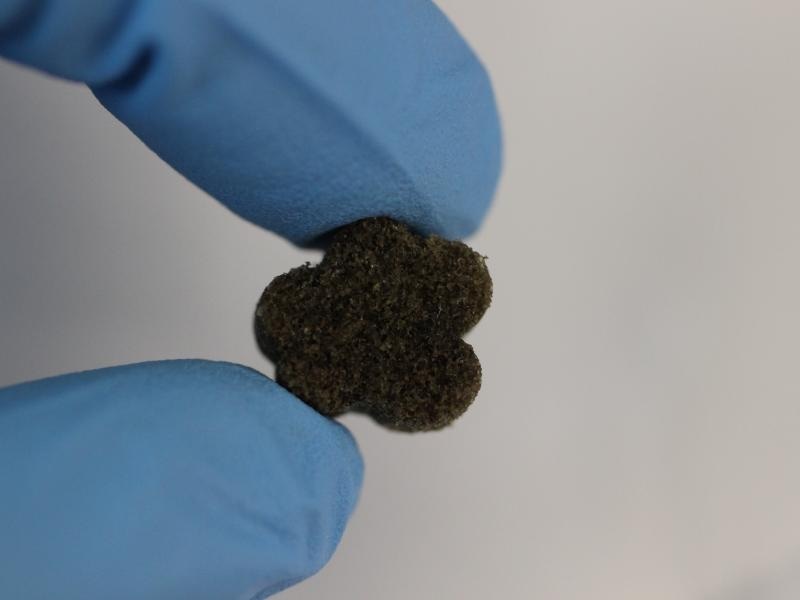Apr 10 2017
 Credit: Rensselaer Polytechnic Institute
Credit: Rensselaer Polytechnic Institute
A new material that can be used to replace skull bone lost to injury, birth defect, or surgery is being developed by a team including researchers from Rensselaer Polytechnic Institute. When exposed to warm saline, this bioactive foam becomes malleable, thus allowing surgeons to easily shape it to fit uneven defects in the skull, where it hardens in place. After the foam is implanted in the skull, specially coated pores within the foam start to attract bone cells, thereby naturally regenerating bone to replace the foam, which eventually dissolves .
The foam, which is a shape memory polymer coated in a bioactive polydopamine, is projected as a substitute for materials used to treat cranio-maxillofacial gaps at present. Most frequently, these types of gaps are filled with a bone graft surgically harvested from the patient, such as from the hip. Such inflexible bone grafts are often hard to harvest, and cannot be easily manipulated to fit within unevenly shaped bone defects, compromising healing.
The research is led by Texas A&M University associate professor Melissa Grunlan, who developed the foam. It is supported by a four-year $1.9 million grant from the National Institutes of Health (NIH).
This is like trying to fill in a missing puzzle piece with the wrong piece. These bone defects can cause tremendous functional problems and aesthetic issues for individuals, so it was recognized that a better treatment would make a big impact.
Melissa Grunlan, Associate Professor, Texas A&M University
Mariah Hahn, a Rensselaer professor of biomedical engineering and an expert in bone tissue engineering, will analyze a number of formulations of the foam in vitro, recommending the most successful formulations for additional pre-clinical testing, and providing deep understanding into why certain foams are more or less successful in boosting bone growth.
We want to find the ideal formulation that maintains the amazing shape memory properties of the foam while providing the optimal environment for stimulating new bone formation.
Mariah Hahn, Rensselaer Center for Biotechnology and Interdisciplinary Studies
Hahn’s expertise in bone formation and bone tissue engineering was an added advantage to the research while assessing the materials and recommending next steps to enhance the formulations. Hahn’s research looks at understanding cell-to-material and cell-to-cell interactions at a primary level. The Hahn Tissue Lab is equipped in regeneration of chronically scarred tissue and at developing tissue-engineered replacements for diseased osteochondral tissues and small-caliber arteries. The lab is also keen on developing tissue-engineered disease models.
About five years ago this project was started, and it has already exhibited good biocompatibility in initial tests in small animal models. Additional years of refinement and testing are needed before a product can be used by surgeons as a treatment option. However, said Hahn, the approach has numerous advantages, especially when contrasted with other options under research, such as 3D printing techniques.
A moldable bone-promoting scaffold could have broad use if it’s successful. It takes advantages of the body’s own healing ability, and it’s a low-cost, ‘off the shelf’ solution that would not need to be pre-tailored to the individual defect.
Mariah Hahn, Rensselaer Center for Biotechnology and Interdisciplinary Studies
For this research, Hahn and Grunlan are joined by Texas A&M researchers Dr. W. Brian Saunders and Dr. Roy Pool in the College of Veterinary Medicine and Biomedical Sciences, and Michael Moreno, a professor of mechanical engineering.
Hahn’s research is facilitated by the vision of The New Polytechnic, an up-and-coming paradigm for higher education which identifies that international challenges and opportunities are so immense they cannot be sufficiently addressed by even highly skilled person working alone. Rensselaer serves as a crossroads for partnership — working with partners across sectors, disciplines, and geographic regions — to resolve complex global challenges, using the highly advanced tools and technologies, a number of which are developed at Rensselaer. Research conducted at Rensselaer looks into some of the world’s most demanding technological challenges — from sustainable development and energy security to human health and biotechnology. The New Polytechnic is transformative in the worldwide impact of research, in its pioneering pedagogy, and in the lives of students at Rensselaer.